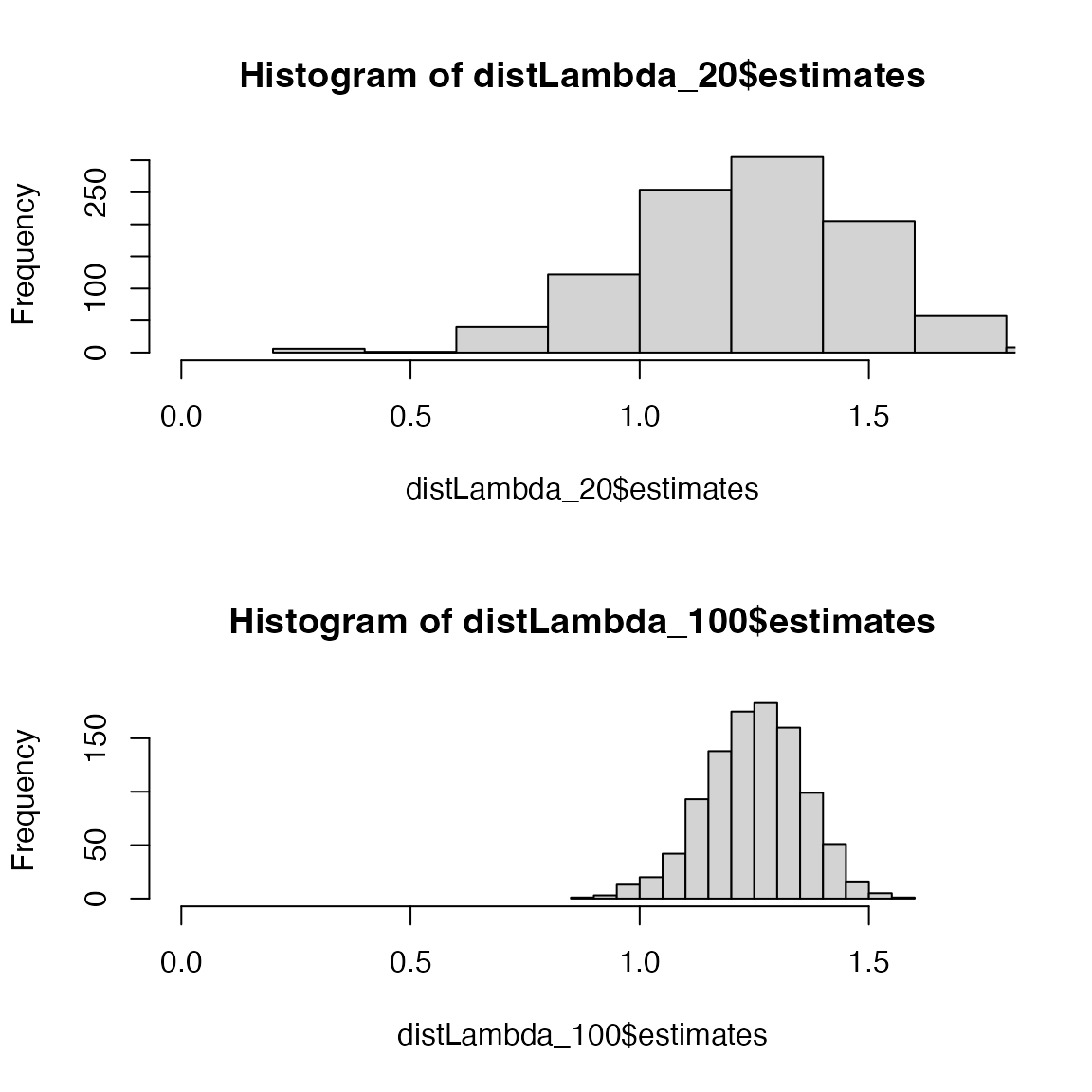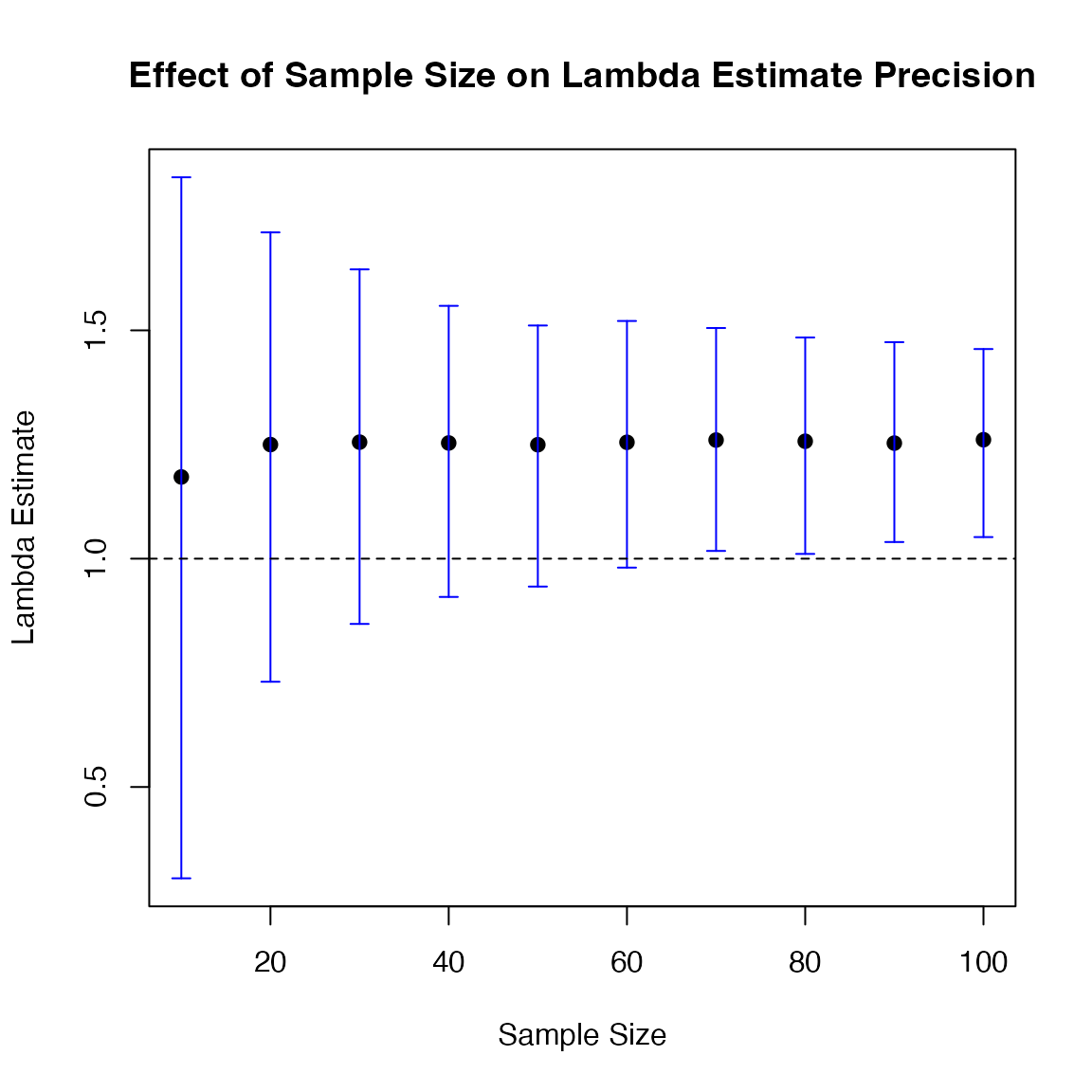Sampling error and its propagation
2025-07-01
Source:vignettes/sampling_error_propagation.Rmd
sampling_error_propagation.RmdIntroduction
Uncertainty in the individual elements of a matrix population model (MPM) can propagate, affecting the accuracy of metrics derived from the model, such as population growth rate, generation time, etc.
One approach to estimate this uncertainty is parametric bootstrapping, a resampling method that explicitly assumes statistical distributions for matrix elements and generates a range of possible matrices based on these assumptions. For example, reproductive output can be modelled as a Poisson-distributed process, suitable for count-based data, while survival can be represented by a binomial distribution, reflecting the probability of individual survival. These assumptions allow for more realistic variability in parameter estimates compared to nonparametric methods. Note that this approach does not assume that the initial matrices represent the “true” parameters; rather, it treats them as estimates with associated uncertainty. The parametric bootstrap is used precisely to quantify this uncertainty by resampling based on these estimated parameters.
The compute_ci function uses parametric bootstrapping to
estimate a 95% confidence interval (95% CI) for any MPM-derived metric.
Specifically, it repeatedly samples matrix elements from their assumed
distributions, generating a sampling distribution of the metric of
interest. The 95% CI is calculated from the 2.5th and 97.5th percentiles
of this distribution, providing an empirical range that quantifies
uncertainty.
The width and shape of the sampling distribution—and consequently,
the confidence intervals—are influenced by several factors, including
the sample size used for estimating matrix elements, the matrix model’s
structure, the assumptions underlying the compute_ci
function, and the distribution of uncertainties across matrix elements.
A narrower confidence interval indicates greater precision, but this
precision depends on the quality of the underlying assumptions. To
accurately assess the reliability of MPM estimates, it is necessary to
carefully consider these factors when interpreting the results.
The following examples show how to use these functions.
Aims
The purpose of this vignette is to illustrate how to use
mpmsim to assess and estimate sampling error in MPMs and
how this uncertainty propagates into derived metrics. This approach is
useful for several reasons, including:
- Estimating confidence intervals (CIs) for key demographic metrics, such as population growth rate using parametric bootstrapping methods.
- Exploring the impact of sample size on the precision of estimates for population growth rate and other metrics derived from MPMs.
- Evaluating the propagation of uncertainty across different matrix elements and submatrices (survival/growth vs. reproduction) in MPMs.
Estimate 95% Confidence Intervals
We can estimate the 95% CI for any metric derived from a matrix population model. In this example, we focus on the population growth rate, .
Consider a matrix model A, which is composed of submatrices U (survival/growth) and F (sexual reproduction), such that A = U + F.
The methods require that the matrix model be split into its component submatrices because the underlying processes are governed by distributions with different statistical properties: individual survival is treated as a binary process (0 = dies, 1 = survives), whereas individual reproduction follows a Poisson distribution.
In this example, the matrix is simple, with only the top-right element representing reproduction, while all other elements represent survival or growth. The method assumes that the matrices represent the true values, for which we wish to calculate confidence intervals.
We can enter these matrices into R as follows, first entering the U and F matrices, and then summing them to get the A matrix.
matU <- matrix(c(
0.1, 0.0,
0.2, 0.4
), byrow = TRUE, nrow = 2)
matF <- matrix(c(
0.0, 5.0,
0.0, 0.0
), byrow = TRUE, nrow = 2)
matA <- matU + matFThe estimated population growth rate
()
can be calculated using the eigs function from the
popdemo package like this:
popdemo::eigs(matA, what = "lambda")
#> [1] 1.261187We can now estimate the 95% CI for this estimate, based on a knowledge of the sample size(s) used to parameterise the MPM.
If the sample size used to estimate each element of the matrix is
20 individuals, we can estimate the 95% CI for
using the compute_ci function. This function requires
several arguments: mat_U and mat_F represent
the survival/growth matrix and reproductive output matrix respectively,
and sample_size specifies the number of individuals used to
estimate each element (in this case, 20). The argument
FUN defines the function to be applied to the resulting
A matrix to calculate the desired metric.
compute_ci(
mat_U = matU, mat_F = matF, sample_size = 20,
FUN = popdemo::eigs, what = "lambda"
)
#> 2.5% 97.5%
#> 0.7097788 1.7020301We can examine the sampling distribution of these
estimates by using the argument dist.out = TRUE.
distLambda_20 <- compute_ci(
mat_U = matU, mat_F = matF,
sample_size = 20, FUN = popdemo::eigs, what = "lambda",
dist.out = TRUE
)
hist(distLambda_20$estimates)
Sample sizes that vary across the MPM
In the above example, it is assumed that the sample size used to make the parameter estimates (i.e. each element of the matrix model) was the same throughout the model. However, sample size might vary across different parts of the matrix or submatrices due to variations in data availability or biological processes. For example, data on survival and growth (represented in the U matrix) might be more abundant because these processes can often be tracked more easily in field studies. In contrast, reproductive output data (represented in the F matrix) may be harder to collect, especially for species with complex reproductive cycles, leading to smaller sample sizes. Additionally, environmental factors or study limitations can result in unequal sampling efforts across different life stages, contributing to varying sample sizes in the matrix elements.
To account for this, the compute_ci function allows
flexibility in specifying sample size, which can be added in several
ways to control how variability is modelled across different parts of
the matrix. As an alternative to providing a single value to apply
uniformly to all elements (as done above) you can provide a matrix
specifying sample sizes for each element, or a list of matrices for
distinct components (e.g., U and F
matrices). This flexibility helps tailor the modelling of uncertainty to
reflect different data availability across biological processes.
For instance, in the following code, we use the same MPM as above,
split into U and F submatrices
(matU and matF, respectively), but now assume
that sample size varies between these components, with 40
individuals for U and 15 for
F. Here, the sample size is consistent across all
elements within the U matrix, but you could also assign
different sample sizes to individual elements of the matrix, allowing
for different sample sizes for different transitions.
# Define the sample sizes for U
mat_U_ss <- matrix(c(
40, 40,
40, 40
), byrow = TRUE, nrow = 2)
# Define sample sizes for F
mat_F_ss <- matrix(c(
0.0, 15,
0.0, 0.0
), byrow = TRUE, nrow = 2)
# Combine sample sizes into list
sampleSizes <- list(mat_U_ss = mat_U_ss, mat_F_ss = mat_F_ss)
# Calculate CI for lambda
compute_ci(
mat_U = matU, mat_F = matF, sample_size = sampleSizes,
FUN = popdemo::eigs, what = "lambda"
)
#> 2.5% 97.5%
#> 0.895995 1.579860Exploring the impact of sample size
Sample size is critical in determining the precision of statistical estimates. In demographic studies, small sample sizes can lead to high uncertainty in estimates of derived measures like , making it difficult to make strong inferences. Larger sample sizes reduce this uncertainty, as seen in the narrower confidence intervals around when we increase the sample size from 20 (calculated above) to 100 (below).
distLambda_100 <- compute_ci(
mat_U = matU, mat_F = matF,
sample_size = 100, FUN = popdemo::eigs, what = "lambda",
dist.out = TRUE
)
par(mfrow = c(2, 1))
hist(distLambda_20$estimates, xlim = c(0, 1.75))
hist(distLambda_100$estimates, xlim = c(0, 1.75))
This approach can be used to perform a form of power analysis by simulation, a technique for determining the sample size required to detect an effect with a specified statistical power and significance level. For instance, one might ask, ’What sample size is needed to confidently conclude that the population growth rate is above 1.0?
The following code creates a plot to visualize how the precision of
estimates improves as sample size increases. It first defines a set of
sample sizes to iterate over, then it uses compute_ci to
calculate the confidence intervals (CIs) for
estimated from MPMs based on these sample sizes. It then plots
estimates and their CIs, along with a reference line at
.
The goal is to show that as the sample size increases, the width of the
CIs shrinks, increasing our confidence in the value of
.
In this case, a sample size of approximately 70 appears sufficient. However, sample size likely has greater importance for the more elastic elements of the MPM. Therefore, focusing on these elements could help users better understand the specific sample size requirements for their system. This targeted approach would lead to a more nuanced study design, allowing for optimized sampling efforts in the areas where precision matters most.
# Define sample sizes to iterate over
sample_sizes <- seq(10, 100, 10)
# Lambda value for reference
matA <- matF + matU
true_lambda <- popdemo::eigs(matA, what = "lambda")
# Initialize an empty data frame with predefined columns
ci_results <- data.frame(
sample_size = sample_sizes,
ci_lower = numeric(length(sample_sizes)),
ci_upper = numeric(length(sample_sizes)),
estimate_mean = numeric(length(sample_sizes))
)
# Loop through each sample size and calculate the CI for lambda
for (i in seq_along(sample_sizes)) {
n <- sample_sizes[i]
# Compute CI for the current sample size
dist_lambda <- compute_ci(
mat_U = matU, mat_F = matF,
sample_size = n, FUN = popdemo::eigs, what = "lambda",
dist.out = TRUE
)
# Calculate 95% CI from the distribution
ci_results$ci_lower[i] <- quantile(dist_lambda$estimates, 0.025)
ci_results$ci_upper[i] <- quantile(dist_lambda$estimates, 0.975)
ci_results$estimate_mean[i] <- mean(dist_lambda$estimates)
}
# Calculate error bars
ci_lower_error <- ci_results$estimate_mean - ci_results$ci_lower
ci_upper_error <- ci_results$ci_upper - ci_results$estimate_mean
# Create the plot
plot(ci_results$sample_size, ci_results$estimate_mean,
ylim = range(ci_results$ci_lower, ci_results$ci_upper),
pch = 19, xlab = "Sample Size", ylab = "Lambda Estimate",
main = "Effect of Sample Size on Lambda Estimate Precision"
)
# Add error bars and reference line
arrows(ci_results$sample_size, ci_results$ci_lower,
ci_results$sample_size, ci_results$ci_upper,
angle = 90, code = 3, length = 0.05, col = "blue"
)
abline(h = 1, lty = 2)
Conclusion
This vignette demonstrates how sampling error propagates through
MPMs, influencing metrics like population growth rate, and provides a
practical method for estimating confidence intervals for these metrics
using compute_ci. By applying tools like
compute_ci, users can also evaluate the effect of sample
size on estimate precision, using this information to optimize data
collection efforts and improve the reliability of demographic
estimates.
Addendum
The compute_ci function is intended for metrics that
rely on the full A matrix. However, some metrics, like
life_expect_mean from the Rage package, only
require the U matrix. For metrics such as these, users
should use the compute_ci_U function, which works similarly
to compute_ci, but is specifically designed for metrics
that focus solely on survival and growth processes within the
U matrix.